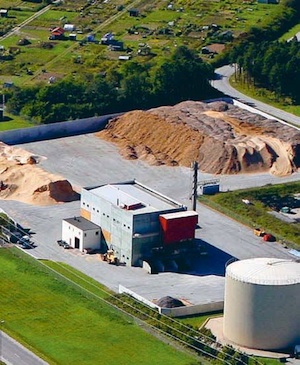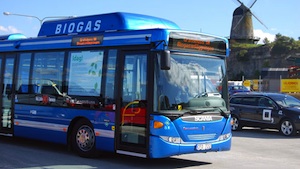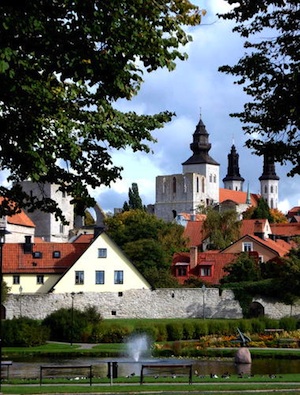Bio-fuelled district heating
A former Viking site on the island of Gotland, Visby was the main centre of the Hanseatic League in the Baltic from the 12th to the 14th century. Its 13th-century ramparts and more than 200 warehouses and wealthy merchants’ dwellings from the same period make it the best-preserved fortified commercial city in northern Europe.
Как элемент в сохранении здания Висбю, строительство сети теплоснабжения началось некоторое 30 лет назад. Сейчас, Все тепло в системы централизованного теплоснабжения Висбю производится с использованием комплекса возобновляемых источников энергии.
Visby’s district heating project is not an isolated case on an island where the use of renewable is guaranteed. Gotland is a showcase for a number of interesting and innovative renewable energy initiatives. This is not really surprising. Gotland has Sweden’s highest sunshine figures, enjoys good access to biofuels and is one of the best European locations for wind power. These natural assets, the entrepreneurship of the islanders and the municipality’s focus on strategic environmental planning have led to the realisation of many ideas for increasing the sustainability of Gotland’s local energy supply.
Биотопливо в теплоснабжении Висбю
The World Heritage City of Visby consists of many unique buildings and mediaeval ruins that are built from limestone. Некоторые из его старых зданий также красивыми резными порталами и фризы в песчанике Готланд. Оба эти камни чувствительны этих загрязнителей в воздухе и, в частности, выбросы от сжигания ископаемого топлива.
В Висбю в целом, централизованного теплоснабжения составляет более 80 процентов всех отопительных поставляются коммерческим помещений и жилищ. В интересах жителей Висбю и наследия города, это нагревание способствует устойчивому обществу.
Environmental benefits are evident, since fossil fuels have not been used in Visby’s district heating since 2006. Централизованное теплоснабжение устраняет необходимость транспортировки топлива в узких улицах центра города Висбю. Более того, the use of biofuels reduces the emission of sulphur and nitrogen oxides. По сравнению с использованием ископаемого топлива, это также снижает чистым добавлением углекислого газа в атмосферу.
С 1980, выбросы серы из централизованного теплоснабжения Висбю упали 95 процент. По сравнению с индивидуальным отоплением, централизованного теплоснабжения оставляет воздухоочистителя и здоровее для жителей Висбю и чувствительной культурного наследия города.
Сети централизованного теплоснабжения в Висбю берет свое тепло от:
- Кора, ветки, филиалы и другие (сколы) Остатки от лесных зазоры и лесопилки.
- Морской воды на основе теплового насоса с 11 МВт.
- Биогаз из уже закрытой свалки в Висбю.
- Биогаз из станции очистки сточных вод.
- Био-масла, которые заменить ископаемое масла.
In addition to that, the municipality has set very high standards for energy efficiency and they have launched a new plan for the historic centre, where energy aspects are integrated with a general plan for building conservation.
Eco-Municipality of Gotland
Visby is the seat of Gotland Municipality, which took the view to become “an ecologically sustainable society within the course of a generation”. Many years ago, the Municipality of Gotland adopted a route which would lead away from fossil fuels and towards reduced climate impact. Сегодня, all electricity used in the municipality’s operations is certificated as Good Environmental Choice, which means that it is produced solely from renewable energy sources.
Gotland has implemented interesting reference projects in a wide range of experiences that include wind power, biogas, solar PV and sustainable architecture. The island has been a pioneer in promoting local ownership by wind co-operatives, where around 2000 households are involved.
Ныне, one of the smartest electricity network in the world is currently under development on the island. This allows that by using modern technology, large quantities of renewable energy sources can be integrated in the grid.
Climate change is a complex issue which..
Visby’s bio-fuelled district heating case shows the advantages of a smart alliance between renewable energy and heritage conservation, and can be taken as a model for many historic centres at those latitudes. This project is part of the common objective of achieving energy self-sufficiency from renewables by 2025, taking into account that the realisation of a Sustainable Energy System requires action at all levels of society.
The experience of Visby, and of Gotland in general, becomes more relevant if we take into account the geographical position of the island, in the middle of the Baltic Sea, that makes it a natural meeting place for cooperation between regions in the Baltic Sea Region.


















